They’re tiny and adorable with larger-than-life personalities. But if you’re thinking of getting a Miniature Horse, there are some important things you should know about Miniature Horse care before bringing one home.
A Miniature Horse that is cared for well can live into his 30s, but to have a long, healthy life, he needs to be treated like the special creature he is.
“I’m always telling my clients with Miniatures that they’re not just ‘little big horses,’” says Rebecca Frankeny, VMD, a practicing veterinarian, owner of Juniata Mobile Veterinary Service in central Pennsylvania, and author of Miniature Horses: A Veterinary Guide for Owners and Breeders. “They are metabolically and physiologically different.”
One big difference is that Minis are more prone to dental issues and hyperlipemia (fatty liver disease). Both can cause serious, even fatal, problems, so anyone who owns a Mini—or is considering getting one—should become educated on proper care of the Miniature Horse.
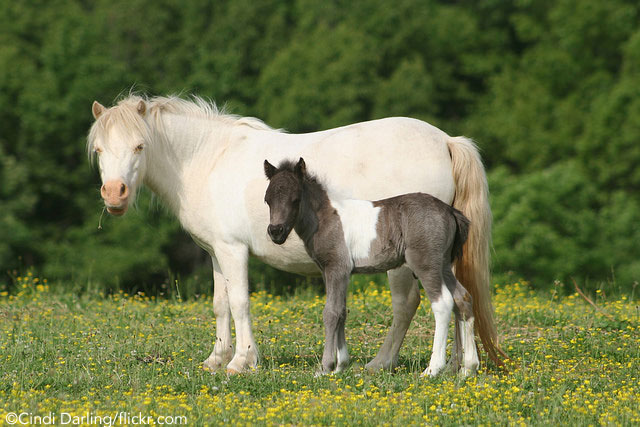
Careful Breeding
The first Miniature Horse was imported into the United States somewhere around 1888. There are now an estimated 100,000 Minis in America, and they can be found in over 30 countries around the world.
It has taken a little more than 350 years to establish the Miniature Horse we know today. Breeders strive to create the smallest possible horse that is well-balanced and with harmonious proportions. Ideally, if someone looks at a picture of a Miniature and has no other point of reference, they should think they’re looking at a full-sized horse.
Unfortunately, this isn’t always the case. Selective inbreeding not only creates horses of diminutive size, but it can also predispose those animals to negative traits.
Dwarfism was a big problem in the breed, and still is to some degree, although not as much as in the past. Some signs of dwarfism include deformities of limbs, spine, head and jaw, resulting in undesirable conformation. In extreme cases, deformities may cause pain and prevent the animal from standing or walking. In mild cases, the dwarf Mini may lead a normal life.
Dwarfism can be avoided when buying from a reputable breeder. This is also a good reason to leave breeding to the experts who understand genetics.
Because they’re so cute, many people decide to breed their Minis without knowing about potential complications. “Minis are far more prone to having trouble with pregnancy and foaling,” notes Frankeny. “These are not horses you can just breed and throw out in the pasture to foal; they will get into trouble.”
Nutrition for the Miniature Horse
It’s rare to find a Mini on the thin side. These darling little equines have a tendency to become obese, which is one of their greatest health challenges. Nutrition is one of the most important aspects of care for the Miniature Horse.
“One of the most common mistakes people make with Minis is letting them get too fat,” says Frankeny. “Minis can basically get fat just breathing air, so it’s very important to have a dry lot [a paddock without grass] because a Mini with access to grass 24/7 will get fat, fat, fat. The Minis in my barn only spend an hour a day on pasture, but they look good.”
She finds that owners tend to feed too much, perhaps because they think their Minis weigh more than they actually do. Studies have found that using a standard weight tape does not provide accurate assessments with Miniature Horses. The following formula has been found to be accurate to within 5 percent of actual scale weight:
Estimated Body Weight (lbs) = (9.36 x girth inches) + (5 x body length in inches) – 348.5
Frankeny urges Mini owners to use the Henneke Body Condition Score (BCS) chart and adjust feed amounts to maintain their horse at a BCS of about 5.
Don’t assume your Mini is at the right weight just by looking at him.
“At least once a week, you need to actually get your hands on them. Because they are so fuzzy, an older Mini can get too thin, if you just go by looks,” says Frankeny. “You don’t want to see the ribs, but you should be able to easily feel them without pushing through inches of fat.”
Forage should always be the foundation of every horse’s diet, and Frankeny recommends good-quality grass hay. “In general, alfalfa is high in protein and is too rich with too many calories, so unless you have a performance Mini you are driving a lot, he doesn’t need that,” she notes.
The average 250-pound Mini kept as a pet (not working or showing) will only require approximately 1.5 percent of his body weight in forage each day. That amounts to just 3.5 pounds of hay; far less than what a typical flake of hay weighs, so you can see how it’s easy to overfeed. To slow down hay consumption, Frankeny recommends using one of the various slow feeders on the market.
Whether or not concentrate is needed depends on the quality of the forage you’re feeding. Feed companies manufacture low-calorie rations that can be especially helpful when feeding Minis.
Fresh, clean water and a salt block should be available at all times.
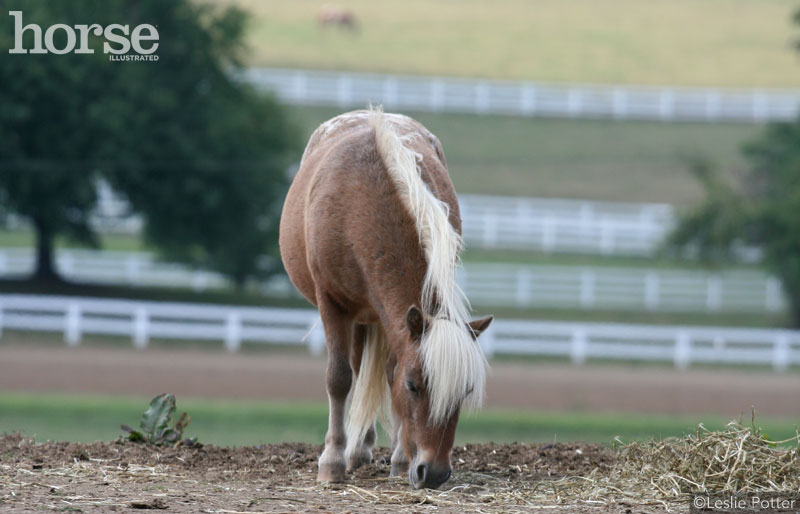
Dental Health
Miniature Horses have the same number and size of teeth found in large breeds, just squeezed into a much smaller head. This tends to result in overcrowding and other dental problems.
It’s not unusual for Minis to retain their baby teeth; this can result in difficulty chewing and/or drooling. Overbites (“parrot mouth”) and underbites (“monkey mouth”) are common. Either can cause abnormal wear of the teeth, which can lead to digestive problems.
Sinus problems can also be found in horses with dental trouble. Signs of sinus trouble may include nasal discharge, swelling under the eye, and tearing of the eye.
Frankeny recommends periodic checks of the young Mini’s mouth during the first year of life to address any abnormalities.
“A lot of the dental problems common to Minis develop as they’re growing, so if you can recognize it early on, you can do some things to improve it. You can’t change anything once they are adults.”
To maintain their dental care, Miniature Horses should have dental exams annually.
Digestive Woes
Minis tend to vacuum up every morsel when they eat, which can lead to sand colic if they pick up dirt and debris. When sand accumulates in the colon, it can cause inflammation, diarrhea, and in extreme cases, obstruction. Choose a feeder that keeps hay and feed out of the dirt. Placing feeders on top of large rubber mats and sweeping them off daily will help substantially.
Some owners treat for sand ingestion by administering a product containing psyllium. If a large amount of sand has accumulated in the colon, surgery may be necessary.
Minis also face a greater risk than other breeds of forming enteroliths, which are stones that form in the colon. Enteroliths are comprised of minerals that build up around a small foreign body, such as a piece of rock or other debris that is swallowed. It’s more often seen when horses are fed alfalfa, which contains higher amounts of phosphorus, protein and magnesium than other hay.
Small enteroliths can be passed, but if they become too large, they can cause obstruction and must be removed surgically. If your Mini has repeated episodes of colic, an enterolith may be to blame. Your vet will likely order abdominal X-rays, as these are highly accurate in diagnosing this specific problem.
Another potential problem is fecoliths, stone-like balls of hardened manure, long-stemmed forage, hair, and/or string. Like an enterolith, they can sometimes get large enough to cause obstruction in the colon.
Hyperlipemia Concerns
Always be observant of appetite. If stress, illness or anything else negatively affects a Mini’s appetite, this is a red flag and a call for close observation.
“In some cases, the first sign you see of a fatty-liver problem is that the Mini isn’t eating,” notes Frankeny. “There aren’t many finicky eaters in the Mini world, so when a Mini doesn’t eat, call your veterinarian. If a secondary problem with the liver is developing, prompt attention provides the best chance of reversing the problem.”
If your Mini doesn’t eat for more than 24 hours, you could be facing the health crisis of hyperlipemia, also known as fatty liver disease.
Minis are naturally at greater risk for this disorder in which high amounts of fat rapidly accumulate inside the liver cells, interfering with normal function. Unless quickly treated, this can lead to liver failure or rupture and death.
Seek immediate veterinary care if your Miniature Horse has declining appetite, lethargy or weakness. The disease soon progresses to incoordination, abdominal pain, tremors, diarrhea, jaundiced coloration, seizure, and head pressing. The animal will die if untreated, and if treatment is delayed, mortality rate can be as high as 70 percent.
When hyperlipemia is suspected, a veterinarian can confirm it with a blood test. If the test is positive, your vet will typically administer intravenous glucose, nutritional support and insulin therapy. Prognosis is good for full recovery if the problem is caught in the early stages.
Vaccinations & Deworming
The same diseases that affect big horses can strike Minis, so you’ll want to protect yours with a regular vaccination program to care for your Miniature Horse properly. Your vet will advise you as to what vaccines your horse will need, based on your region and your Mini’s exposure to other horses.
Just as with any breed of horse, your deworming protocol should include fecal testing to determine parasite load and which dewormers are most effective.
“It’s easy to overdose Minis with medications because of their low weight, so you must be careful when giving a dewormer or any prescription medication and follow your vet’s recommendations,” says Frankeny.
Exercise of the Miniature Horse
Frankeny recommends no less than a 60 by 60-foot enclosure, but adds that how much room a Mini needs depends on his activity level. She also suggests safe toys, such as balls and cones, for entertainment.
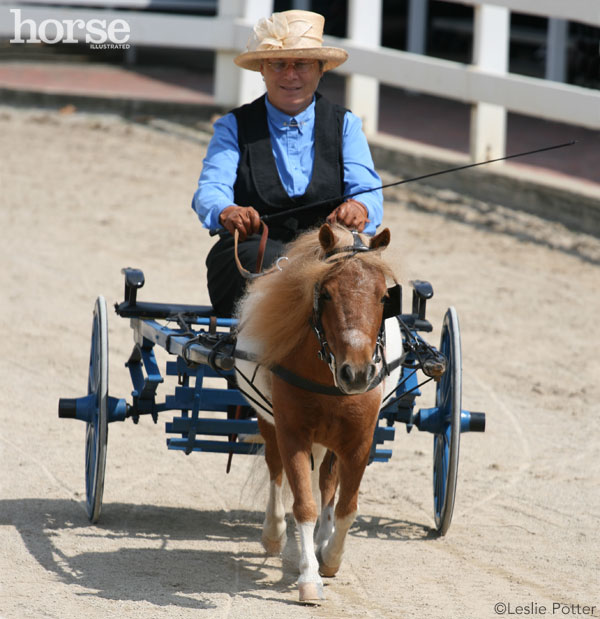
“Being active and moving around helps prevent colic. I encourage people to do things with their Minis for exercise and mental stimulation,” she notes. “There are obstacle classes, high-jumping and agility classes. I have one client who does clicker training with her Minis and teaches them tricks.”
One big plus with Minis is that they don’t tend to suffer from arthritis and musculoskeletal degeneration. They don’t face the same joint problems as big horses because they’re not carrying as much weight.
Hoof Care of the Miniature Horse
“Miniature Horses need the same level of care as a normal-sized horse, and this includes regular trimming,” says certified journeyman farrier Bryan Farcus, author of Miniature Horse Hoof Care.
Minis should have their feet trimmed on a schedule similar to that of larger horses. Farcus recommends every six to eight weeks, and in some cases more frequently, depending on the individual’s hoof condition and activity level.
“You want to have his feet trimmed according to his conformation so that his whole body is in balance,” says Farcus. “Ideally, he should stand balanced with the angles of his feet the same as the slope of his shoulders and pasterns.”
If your farrier notices a problem with your Mini’s hooves, Farcus advises consulting with your veterinarian, who may wish to order X-rays.
“Don’t shortchange your Mini by skimping on hoof trimming,” says Farcus. “In many cases, the farrier will notice some changes in the feet that can be an indication of something going on elsewhere in the body. Prevention is the best cure. A lot of metabolic issues eventually show up in the hooves; even though they don’t start there, they manifest in the feet. Minis aren’t ridden, so they tend to hide lameness better than a big horse. Certain breeds are at higher risk of laminitis, and Minis fall into this category.”
If your Mini is healthy overall, his hooves will usually be strong and healthy as well. The vast majority of Minis go barefoot. Shoes are used only in therapeutic cases; they must be custom-made.
Finding a good farrier is usually done through word of mouth, so ask for recommendations from your veterinarian, friends who own Minis, or a trainer who specializes in them. Expect to pay the same amount for trimming as you would for a full-size horse.
Your Mini should be taught to cooperate with the farrier.
“So many people think because Minis are small that the farrier can just ‘muscle through it,’ but that doesn’t make for a happy farrier or a happy Mini,” says Farcus. “You should teach your Mini to be ‘farrier friendly’ and stand politely and balanced on three legs just like you would your big horse. With training, they will gladly raise their feet higher than you’d think.”
Easy to Love
Because of their diminutive size, Miniature Horses are safest when kept separate from full-size horses. A big horse could severely injure a Mini if they start playing and kicking. If you have large and small breeds, for safety’s sake, make sure your Mini has his own paddock.
If you’re intimidated by the health concerns specific to Minis, take heart. Many of the potential problems in Miniature Horses mentioned here can be avoided by providing proper care and nutrition.
In fact, most people who fall under the spell of Miniatures don’t have just one. “Minis are like potato chips,” says Frankeny. “People who have them usually have several.”
Liked this article? Here’s more on Minis:
Miniature Horse Breed Profile
Bringing Home a Mini
Miniature Horse Desktop Wallpapers
This article about Miniature Horse Care originally appeared in the April 2014 issue of Horse Illustrated magazine. Click here to subscribe!



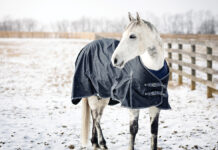
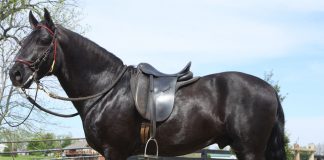

Thank you for this article. I have been thinking about getting a mini filly.
aww, too cute!
good info!
I want a mini!<3
I love my mini and he’s in great shape.
There is no way his teeth are as big as my percheron’s though. Not even close!
I appreciate the article but I could use an illustration or photo of what the feet should look like when properly trimmed. My mini tolerates the trimming, but I am not sure if I have trimmed quite enough.